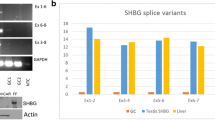Abstract
Pregna-D'-pentaranes (pentaranes) are modified progesterones with demonstrable progestational activity and contraceptive effect. We have examined the steroid binding characteristics of the two newly synthesized progesterone analogs, Pentarane A (16α, 17α-cyclohexanoprogesterone) and Pentarane B (6α-methyl, 16α, 17α-cyclohexanoprogesterone), and studied the nature of their interaction with progesterone receptor (PR) from the chicken oviduct and the calf uterine cytosols. Pregna-D'-pentaranes exhibited no affinity for the chick PR but interacted with the calf uterine PR as did R5020. The pentaranes, however, bound PR less tightly. R5020- or pentarane-bound PR sedimented as an 8S moiety in 8–30% linear glycerol gradients. Thermal transformation of receptor resulted in the reduction of the 8S form, and caused an increase in the binding of R5020-and progesterone-bound PR complexes to DNA-cellulose. The pentarane-bound PR bound poorly, if at all, to DNA-cellulose. Our data suggest that pentaranes exhibit both similarities and differences with natural and synthetic progestins with respect to their interaction with calf uterine PR. The lack of pentarane binding to chicken PR is reminiscent of the general phenomenon that antiprogestins (RU486, ZK98299, and Org 31710 and Org 31806) do not interact with chicken PR. Pentaranes, therefore, represent unique steroid analogs to investigate the molecular mechanism of steroid hormone action.
Similar content being viewed by others
Abbreviations
- DMSO:
-
Dimethyl sulfoxide
- DTT:
-
Dithiothreitol
- E:
-
Estradiol
- EDTA:
-
Ethylene-diaminetetraacetate
- F:
-
Cortisol
- IA:
-
Iodoacetamide
- MER:
-
β-mercaptoethanol
- MTG:
-
Monothioglycerol
- NEM:
-
N-ethylmaleimide
- Org 31710:
-
(6β, 11β, 17β)-11-(4-dimethylaminophenyl)-6 methyl-4′, 5′-dihydro[estra-4, 9-diene-17, 2′(3H')-furna]-3-one
- Org 31806:
-
(7β, 11β, 17β)-11-(4-dimethyl-aminophenyl)-7 methyl-4′, 5′-dihydro[estra-4, 9-diene-17, 2′(3H)-furan]-3-one
- P:
-
Progesterone
- Pentarane A:
-
16α, 17α-cyclohexanoprogesterone
- Pentarane B:
-
6α-methyl, 16α, 17α-cyclohexanoprogesterone
- PMSF:
-
Phenylmethylsulfonyl Fluoride
- PR:
-
Progesterone Receptor
- R5020:
-
17, 21-dimethylpregna-4, 9(10)-diene-3
References
Moudgil VK: Steroid receptors in health and disease. In: Moudgil VK (ed.) Steroid Receptors in Health and Disease. Plenum Press, New York, 1988, pp 3–24
Baulieu EE: Contragestion and other clinical applications of RU486, an antiprogesterone at the receptor. Science 245: 1351–1357, 1989
Yamamoto KR: Steroid receptor regulated transcription of specific genes and gene networks. Ann Rev Genet 19: 209–252, 1985
Evans RM: The steroid and thyroid hormone receptor superfamily. Science 240: 889–895, 1988
King WJ, Greene GL: Monoclonal antibodies localize oestrogen receptor in the nuclei of target cells. Nature 307: 745–747, 1984
Welshons WV, Lieberman ME, Gorski J: Nuclear localization of unoccupied oestrogen receptors. Nature 307: 747–749, 1984
Gasc JM, Renoir JM, Radanyi C, Joab I, Tochimaa P, Baulieu EE: Progesterone receptor in the chick oviduct: An immunohistochemical study with antibodies to distinct receptor components. J Cell Biol 99: 1193–1201, 1984
Welshons WV, Krummel BM, Gorski J: Nuclear localization of unoccupied receptors for glucocorticoids, estrogens, and progesterone in GH3 cells. Endocrinology 117: 2140–2147, 1985
Shull JD, Welshons WV, Lieberman ME, Gorski J: Rat pituitary estrogen receptor: Role of the nuclear receptor in the regulation of transcription of the prolactin gene and the nuclear localization of the unoccupied receptor. In: Moudgil VK (ed.) Molecular Mechanisms of Steroid Hormone Action: recent advances. Walter de Gruyter, Berlin and New York, 1985, pp 539–562
Milgrom E: Activation of steroid-receptor complexes. Biochem Actions Horm 13: 465–492, 1981
Moudgil VK, Toft DO: Binding of ATP to progesterone receptors. Proc Natl Acad Sci USA 72: 901–905, 1975
Miller JB, Toft DO: Requirement of activation in the binding of progesterone receptor to ATP-Sepharose. Biochemistry 17: 173–177, 1978
Moudgil VK, John JK: ATP-dependent activation of glucocorticoid receptor from rat liver cytosol. Biochem J 190: 799–808, 1980
Moudgil VK, Kruczak VH, Eessalu TE, Paulose C, Taylor MG, Hansen JC: Activation of progesterone recptor by ATP. Eur J Biochem 118: 447–555, 1981
Moudgil VK, Eessalu TE, Bouchou T, Renoir MJ, Mester J, Baulieu EE: Transformation of chick oviduct progesterone receptorin vitro: Effects of hormone, salt, heat and adenosine triphosphate. Endocrinology 116: 1267–1274, 1985
Moudgil VK, Hurd C: Transformation of calf uterine progesterone receptor: Analysis of the process when receptor is bound to progesterone and RU38486. Biochemistry 26: 4993–5001, 1987
Moudgil VK, Vendenheede L, Hurd C, Eliezer N, Lombardo G:In vitro modulation of rat liver glucocorticoid receptor by urea. J Biol Chem 262: 5180–5187, 1987
Catelli MG, Binart N, Jung-Testas I, Renoir JM, Baulieu EE, Fergmisco JR, Welch WJ: The common 90-kd protein component of non-transformed 8 S steroid receptors is a heat shock protein. EMBO J 4: 3131–3135, 1985
Philibert D, Ojasoo T, Raynaud JP: Properties of the cytoplasmic progestin-binding protein in the rabbit uterus. Endocrinology 101: 1850–1861, 1977
Theofan G, Notides AC: Characterization of the calf uterine progesterone receptor and its stabilization by nucleic acids. Endocrinology 114: 1173–1179, 1982
Levina IS, Kemernitzky AV, Fachenko ND, Simonov VI: Relationship between structure and mode of action of 16 alfa, 17 alfa-cycloalkanoprogesterones (pregna-D'-pentaranes). Endokrinologie 80: 3, 266–274, 1982
Kalimi M, Love K: Role of chemical reagents in the activation of rat hepatic glucocorticoid-receptor complex. J Biol Chem 255: 4687–4690, 1980
Bodwell JE, Holbrook NJ, Munck A: Evidence for distinct sulfhydryl groups associated with steroid and DNA binding domains of rat thymus glucocorticoid receptors. Biochemistry 23: 4237–4242, 1984
Tienrungroj W, Meshinchi S, Sanchez ER, Pratt SE, Grippo JF, Holmgren A, Pratt WB: Role of sulfhydryl groups in permitting transformation and DNA binding of the glucocorticoid receptor. J Biol Chem 262: 6992–7000, 1987
Peleg S, Schrader WT, O'Malley BW: Differential sensitivity of chicken progesterone receptor forms to sulfhydryl reactive reagents. Biochemistry 28: 7373–7379, 1989
Moudgil VK, Anter MJ, Hurd C: Mammalian progesterone receptor shows differential sensitivity to sulfhydryl group modifying agents when bound to agonist and antagonist ligands. J Biol Chem 264: 2203–2211, 1989
Simons SS, Pumphrey JG, Rudikoff S, Eisen HJ: Identification of cysteine 656 as the amino acid of hepatoma tissue culture cell glucocorticoid receptors that is covalently labeled by dexamethasone 21-mesylate. J Biol Chem 262: 9676–9680, 1987
Harlow KW, Smith DN, Katzenellenbogen JA, Greene GL, Katzenellenbogen BS: Identification of cysteine 530 as the covalent attachment site of an affinity labeling estrogen (ketononestrol aziridine) and antiestrogen (Tamoxifen aziridine) in the human estrogen receptor. J Biol Chem 264: 17476–17485, 1989
Green S, Chambon P: oestradiol induction of a glucocorticoid-responsive gene by a chimeric receptor. Nature 325: 75–78, 1987
Toft DO, O'Malley BW: Target tissue receptors for progesterone: The influence of estrogen treatment. Endocrinology 90: 1041–1045, 1972
Mester J, Gasc JM, Buchou T, Renoir JM, Irene J, Radanyi C, Binart N, Catelli MG, Baulieu EE: Structure, properties, and subcellular localization of the chick oviduct progesterone receptor. In: Moudgil VK (ed.) Molecular Mechanism of Steroid Hormone Action: recent advances. Walter de Gruyter, Berlin and New York, 1985, pp 31–60
Moudgil VK: In: Agarwal MK (ed.) Principles of Recepterology. Walter de Gruyter, Berlin and New York, 1983, pp 273–379
Coneely OM, Sullivan WP, Toft DO, Birnbaumer M, Cook RG, Maxwell BL, Zarucki-Schulz T, Green GL, Scharder WT, O'Malley BW: Molecular cloning of the chicken progesterone receptor. Science 233: 767–770, 1986
Horwitz KB, Wei LL, Sediacek SM, d'Arville CN: Progestin action and progesterone receptor structure in human breast cancer: A review. Rec Prog Horm Res 41: 249–301, 1985
Moudgil VK, Lombardo G, Hurd C, Eliezer N, Agarwal MK: Hormone dependency of transformation of rat liver glucocorticoid receptorin vitro: Effects of heat, salt, and nucleotides. Biochim Biophys Acta 889: 192–199, 1986
Eliezer N, Hurd C, Moudgil VK: Immunologically distinct binding molecules for progesterone and RU38486 in the chick oviduct cytosol. Biochim Biophys Acta 929: 34–39, 1987
Moudgil VK, Nath R, Bhakta A, Nakao M: ZK98299, a novel antiprogesterone that doe not interact with chicken oviduct progesterone receptor. Biochim Biophys Acta 1094: 185–192, 1991
Mizutani T, Bhakta A, Kloosterboer HJ, Moudgil VK: Novel antiprogestins ORG 31806 and 31710: Interaction with mammalian progesterone receptor and DNA binding of antisteroid receptor complexes. J Steroid Biochem Molec Biol 42: 695–704, 1992
Hurd C, Moudgil VK: Characterization of R5020 and RU486 binding to progesterone receptor from the calf uterus. Biochemistry 27: 3618–3623, 1988
Milgrom E, Atger M, Baulieu EE: Acidiphilic activation of steroid hormone receptors. Biochemistry 12: 5198–5205, 1973
Nath R, Bhakta A, Moudgil VK: ZK98299—a new antiprogesterone: Biochemical characterization of steroid binding parameters in the calf uterus cytosol. Arch Biochem Biophys 292: 303–310, 1992
Hurd C, Nakao M, Eliezer N, Moudgil VK: Immunoanalysis of calf uterine progesterone receptor: Modulation of receptor-associated 90 kDa heat-shock protein. Mol and Cell Biochem 105: 73–83, 1991
Moudgil VK, Gunda M: Hepatic glucocorticoid receptor behaves differently when its hormone binding site is occupied by agonist (triamcinolone acetonide) or antagonist (RU486) steroid ligands. Biochem and Biophys Res Commun 174: 1239–1247, 1991
Beato M: Gene regulation by steroid hormones. Cell 56: 335–344, 1989
Author information
Authors and Affiliations
Rights and permissions
About this article
Cite this article
Bhakta, A., Herman, M., Levina, I.S. et al. Interaction of cycloalkanoprogesterones with mammalian progesterone receptor: binding of pregna-D'-pentaranes in the calf uterine cytosol. Mol Cell Biochem 125, 153–161 (1993). https://doi.org/10.1007/BF00936444
Received:
Accepted:
Issue Date:
DOI: https://doi.org/10.1007/BF00936444




